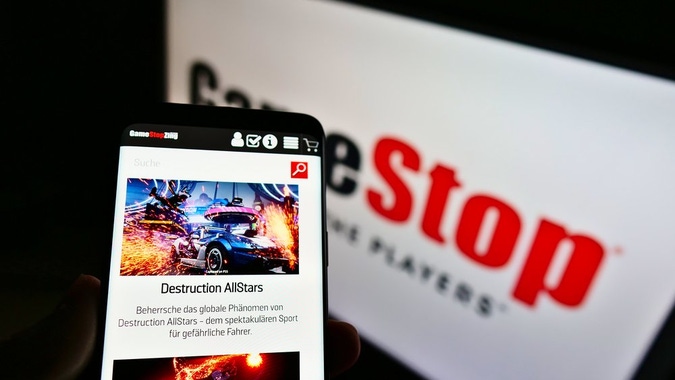
It’s generally big news when a company announces a stock split, but when that company happens to be GameStop Corp. (NYSE: GME) things get downright crazy.

Depositphotos.com contributor/Depositphotos.com – MarketBeat
Shares of the wildly popular meme stock swung back towards $200 on April 1st after GameStop revealed a plan to seek approval for a stock split. While not an April’s Fools Day joke, retail traders were plenty jovial about the headline sending the unprofitable video game retailer’s valuation back up to silly levels. It was another reminder of the disproportionate market reactions that meme stocks can generate.
If the board approves the idea, it won’t be the first time GameStop does the splits. Fifteen years ago, the company opted for a conventional 2-for-1 split soon after it had climbed to an all-time high. My, how things have changed.
What drove the stock then and what drives it now are night and day. Sales of Xbox gaming consoles and Super Mario Brothers games matter little these days. Instead, it is social media that dictates when GameStop trading goes into overdrive. The latest catalyst is causing more of the same.
Why is GameStop Doing a Stock Split?
Aside from rousing its passionate retail shareholder base, GameStop is going the split route to make its stock more affordable. This is often the rationale when other companies split, but with GameStop it carries special meaning.
Following the well-publicized frenzy around the stock after it ran to $483 in January 2021, GameStop management understands that it is its loyal retail trading cadre that moves its stock—and not company fundamentals. By reducing the share price, it hopes to be able to amass even more Reddit and Discord influenced traders to the GameStop army. In turn, the value of the company will theoretically increase as more pile into the meme stock.
GameStop is taking a bit different approach from the typical stock split. Rather than simply issue investors new shares, the split will take the form of a ‘dividend’. Not a cash dividend, but rather a stock dividend meaning shareholders as of a certain cutoff date would simply get more shares. As a result, the number of class A shares outstanding will increase from 300 million to 1 billion.
This is really no different than other splits, just a clever marketing tactic to position it as a ‘dividend’ so shareholders feel they are getting rewarded with some sort of prize. Of course, for a company that posted a $147.5 million fourth quarter loss, there isn’t much cash to be handing out.
How are Meme Stocks Performing in 2022?
Further proof that there is an ETF for everything these days, the Roundhill Meme ETF is a multi-company meme play rolled into one. The index it tracks, the Solactive Roundhill Meme Stock Index, is perhaps our best guide of meme stock performance.
Although the rise of the meme stock began in the early days of the pandemic, the Roundhill meme index began December 8th of last year. Since then, it is down approximately 30%. Year-to-date the meme group has a -23% return.
The meme trade has shown signs of life in recent weeks. Since March 14th, the equal weighted index is up 25%, led by a 111% surge in none other than GameStop. Big reversals in Affirm Holdings, AMC Entertainment, and DoorDash have also led the recent meme stock charge.
Does This Make GameStop Stock a Buy?
So while GameStop’s SEC filing states the purpose of the stock split is to give it “flexibility for future corporate needs”, in reality it is yet another gimmick to entertain its enthusiastic investor base.
As with other stock splits, the move would have no impact on valuation. There would just be more shares flying around at a lower price. The common corporate practice does, however, tend to artificially inflate value if and when new investors bid up what are perceived to be less expensive shares.
With GameStop, news of an approved split could very well spark a rally. It doesn’t take much to excite meme stock traders. Those that feel they were too late to the party before may jump on. Existing shareholders, especially those that are in the red, may make the psychologically motivated move of buying “cheaper” shares.
A near-term gain in the wake of the GameStop split chatter seems plausible for traders looking to ride an apparent meme stock revival. Of course, short sellers will also likely be drawn to the noise seeking to capitalize on another period of emotionally driven trading. And with 20% of GameStop’s float held short, the stage may be again getting set for a high-risk squeeze game of cat and mouse.